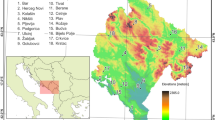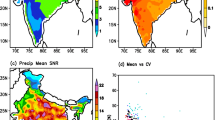Abstract
Available water resources in the Middle East, as one of the most water-scarce regions of the world, have undergone extra pressure due to climatic change, population growth, and economic development during the past decades. The objective of this study is to detect the trends and quantify the changes in aridity with respect to precipitation and potential evapotranspiration in 20 countries of the Middle East and the adjacent area. A pixel-wise trend analysis was conducted on precipitation, potential evapotranspiration, and the aridity index for 71 years from 1948 to 2018. Results showed a statistically significant (|Z| > 1.96) increase up to 106% in aridity (a downward trend in the aridity index) from December to September in most parts of the region. Aridity in October and November had a downward tendency in most parts of the study area. At an annual time scale, 62.5% of the detected trends in aridity were found to be upward (up to 96% increase) due to the combined effects of the decrease in precipitation and the increase in potential evapotranspiration. Annual aridity was found to be downward in 37.5% of the detected trends (up to 61% decrease). The highest and the lowest trends in aridity were found in the north of Sudan (96%) and eastern Arabia (− 61%).










Similar content being viewed by others
References
Almazroui M, Islam MN, Dambul R, Jones PD (2014) Trends of temperature extremes in Saudi Arabia. Int J Climatol 34(3):808–826. https://doi.org/10.1002/joc.3722
Bouraoui F, Vachaud GLZX, Li LZX, Le Treut H, Chen T (1999) Evaluation of the impact of climate changes on water storage and groundwater recharge at the watershed scale. Clim Dyn 15(2):153–161. https://doi.org/10.1007/s003820050274
Bryan K (1996) The steric component of sea level rise associated with enhanced greenhouse warming: a model study. Clim Dyn 12(8):545–555. https://doi.org/10.1007/BF00207938
Chen W, Dong B (2019) Anthropogenic impacts on recent decadal change in temperature extremes over China: relative roles of greenhouse gases and anthropogenic aerosols. Clim Dyn 52(5–6):3643–3660. https://doi.org/10.1007/s00382-018-4342-9
Colston JM, Ahmed T, Mahopo C, Kang G, Kosek M, de Sousa JF, Shrestha PS, Svensen E, Turab A, Zaitchik B, The ME (2018) Evaluating meteorological data from weather stations, and from satellites and global models for a multi-site epidemiological study. Environ Res 165:91–109
Dinpashoh Y, Jhajharia D, Fakheri-Fard A, Singh VP, Kahya E (2011) Trends in reference crop evapotranspiration over Iran. J Hydrol 399(3–4):422–433. https://doi.org/10.1016/j.jhydrol.2011.01.021
D'Oria M, Ferraresi M, Tanda MG (2017) Historical trends and high-resolution future climate projections in northern Tuscany (Italy). J Hydrol 555:708–723. https://doi.org/10.1016/j.jhydrol.2017.10.054
Douville H, Chauvin F, Planton S, Royer JF, Salas-Melia D, Tyteca S (2002) Sensitivity of the hydrological cycle to increasing amounts of greenhouse gases and aerosols. Clim Dyn 20(1):45–68. https://doi.org/10.1007/s00382-002-0259-3
Falkenmark M, Lannerstad M (2005) Consumptive water use to feed humanity-curing a blind spot. Hydrol Earth Syst Sci 9(1/2):15–28. https://doi.org/10.5194/hess-9-15-2005
Fathian F, Morid S, Kahya E (2015) Identification of trends in hydrological and climatic variables in Urmia Lake basin, Iran. Theor Appl Climatol 119(3–4):443–464. https://doi.org/10.1007/s00704-014-1120-4
Fatolazadeh F, Eshagh M, Goïta K (2020) A new approach for generating optimal GLDAS hydrological products and uncertainties. Sci Total Environ 730:138932
Gado TA, El-Hagrsy RM, Rashwan IMH (2019) Spatial and temporal rainfall changes in Egypt. Environ Sci Pollut Res 26(27):28228–28242. https://doi.org/10.1007/s11356-019-06039-4
Gholami V, Jolandan MA, Torkaman J (2017) Evaluation of climate change in northern Iran during the last four centuries by using dendroclimatology. Nat Hazards 85(3):1835–1850. https://doi.org/10.1007/s11069-016-2667-4
Gholami V, Torkaman J, Dalir P (2019) Simulation of precipitation time series using tree-rings, earlywood vessel features, and artificial neural network. Theor Appl Climatol 137(3–4):1939–1948. https://doi.org/10.1007/s00704-018-2702-3
Glickman Todd S, Zenk W (2000) Glossary of meteorology. Am Meteorol Soc
Grove A T (1958) The arid environment. Plants for arid lands. Springer, Dordrecht, 9–18
Güçlü Yavuz S (2020) Improved visualization for trend analysis by comparing with classical Mann-Kendall test and ITA. J Hydrol 584:124674. https://doi.org/10.1016/j.jhydrol.2020.124674
Hasan E, Tarhule A, Zume JT, Kirstetter PE (2019) + 50 years of terrestrial hydroclimatic variability in Africa’s transboundary waters. Sci Rep 9(1):1–12. https://doi.org/10.1038/s41598-019-48813-x
Hollander M, Wolfe, D A, Chicken, E (2013) Nonparametric statistical methods (Vol. 751). John Wiley & Sons
Irmak S, Kabenge I, Skaggs KE, Mutiibwa D (2012) Trend and magnitude of changes in climate variables and reference evapotranspiration over 116-yr period in the Platte River Basin, central Nebraska–USA. J Hydrol 420:228–244. https://doi.org/10.1016/j.jhydrol.2011.12.006
Jhajharia D, Dinpashoh Y, Kahya E, Singh VP, Fakheri-Fard A (2012) Trends in reference evapotranspiration in the humid region of Northeast India. Hydrol Process 26(3):421–435. https://doi.org/10.1002/hyp.8140
Jhajharia D, Dinpashoh Y, Kahya E, Choudhary RR, Singh VP (2014) Trends in temperature over Godavari river basin in southern peninsular India. Int J Climatol 34(5):1369–1384. https://doi.org/10.1002/joc.3761
Joffe G (2016) The impending water crisis in the MENA region. Int Spectator 51(3):55–66. https://doi.org/10.1080/03932729.2016.1198069
Kafle HK, Bruins HJ (2009) Climatic trends in Israel 1970–2002: warmer and increasing aridity inland. Clim Chang 96(1–2):63–77. https://doi.org/10.1007/s10584-009-9578-2
Kamga FM (2001) Impact of greenhouse gas induced climate change on the runoff of the upper Benue River (Cameroon). J Hydrol 252(1-4):145–156. https://doi.org/10.1016/S0022-1694(01)00445-0
Kendall MG (1938) A new measure of rank correlation. Biometrika 30(1/2):81–93
Khan MS, Liaqat UW, Baik J, Choi M (2018) Stand-alone uncertainty characterization of GLEAM, GLDAS and MOD16 evapotranspiration products using an extended triple collocation approach. Agric For Meteorol 252:256–268
Livneh B, Deems JS, Schneider D, Barsugli JJ, Molotch NP (2014) Filling in the gaps: inferring spatially distributed precipitation from gauge observations over complex terrain. Water Resour Res 50(11):8589–8610. https://doi.org/10.1002/2014WR015442
Llopart M, Reboita MS, da Rocha RP (2020) Assessment of multi-model climate projections of water resources over South America CORDEX domain. Clim Dyn 54(1–2):99–116. https://doi.org/10.1007/s00382-019-04990-z
Mann HB (1945) Nonparametric tests against trend. Econometrica: Journal of the econometric society 13:245–259
Middleton N, Thomas D (1997) World atlas of desertification, 2nd edn. Arnold, Hodder Headline, PLC., London
Moghim S (2020) Assessment of water storage changes using GRACE and GLDAS. Water Resour Manag 34(2):685–697
Mudelsee M (2019) Trend analysis of climate time series: a review of methods. Earth Sci Rev 190:310–322. https://doi.org/10.1016/j.earscirev.2018.12.005
Nie W, Zaitchik BF, Rodell M, Kumar SV, Arsenault KR, Li B, Getirana A (2019) Assimilating GRACE into a land surface model in the presence of an irrigation-induced groundwater trend. Water Resour Res 55(12):11274–11294
Oki T, Kanae S (2006) Global hydrological cycles and world water resources. Science 313(5790):1068–1072. https://doi.org/10.1126/science.1128845
Partal T, Kahya E (2006) Trend analysis in Turkish precipitation data. Hydrol Proc: An International Journal 20(9):2011–2026. https://doi.org/10.1002/hyp.5993
Pradhan RK, Sharma D, Panda SK, Dubey SK, Sharma A (2019) Changes of precipitation regime and its indices over Rajasthan state of India: impact of climate change scenarios experiments. Clim Dyn 52(5-6):3405–3420. https://doi.org/10.1007/s00382-018-4334-9
Ramankutty N, Evan AT, Monfreda C, Foley JA (2008) Farming the planet: 1. Geographic distribution of global agricultural lands in the year 2000. Glob Biogeochem Cycles 22(1):GB1003
Risbey JS (2011) Dangerous climate change and water resources in Australia. Reg Environ Chang 11(1):197–203. https://doi.org/10.1007/s10113-010-0176-7
Rodell M, Houser PR, Jambor UEA, Gottschalck J, Mitchell K, Meng CJ, Arsenault K, Cosgrove B, Radakovich J, Bosilovich M, Entin JK (2004) The global land data assimilation system. Bull Am Meteorol Soc 85(3):381–394
Roudi-Fahimi F, Kent M M (2007) Challenges and opportunities-the population of the Middle East and North Africa (Vol. 62, No. 2). Population Reference Bureau
Sahour H, Gholami V, Vazifedan M (2020a) A comparative analysis of statistical and machine learning techniques for mapping the spatial distribution of groundwater salinity in a coastal aquifer. J Hydrol 19:125321
Sahour H, Sultan M, Vazifedan M, Abdelmohsen K, Karki S, Yellich JA, Gebremichael E, Alshehri F, Elbayoumi TM (2020b) Statistical applications to downscale GRACE-derived terrestrial water storage data and to fill temporal gaps. Remote Sens 12:533. https://doi.org/10.3390/rs12030533
Said M, Komakech HC, Munishi LK, Muzuka ANN (2019) Evidence of climate change impacts on water, food and energy resources around Kilimanjaro, Tanzania. Reg Environ Chang 19:2521–2534 1–14. https://doi.org/10.1007/s10113-019-01568-7
Schilling J, Hertig E, Tramblay Y, Scheffran J (2020) Climate change vulnerability, water resources and social implications in North Africa. Reg Environ Chang 20(1):15. https://doi.org/10.1007/s10113-020-01597-7
Sen PK (1968) Estimates of the regression coefficient based on Kendall’s tau. J Am Stat Assoc 63(324):1379–1389
Sheffield J, Goteti G, Wood EF (2006) Development of a 50-year high-resolution global dataset of meteorological forcings for land surface modeling. J Clim 19(13):3088–3111
Some’e BS, Ezani A, Tabari H (2013) Spatiotemporal trends of aridity index in arid and semiarid regions of Iran. Theor Appl Climatol 111(1-2):149–160. https://doi.org/10.1007/s00704-012-0650-x
Soto-Navarro J, Jordá G, Amores A, Cabos W, Somot S, Sevault F, Macias D, Djurdjevic, Sannino L, Li, Sein D (2020) Evolution of Mediterranean Sea water properties under climate change scenarios in the Med-CORDEX ensemble. Clim Dyn 54(3):2135–2165. https://doi.org/10.1007/s00382-019-05105-4
Sprinthall RC, Fisk ST (1990) Basic statistical analysis. Prentice Hall, Englewood Cliffs, NJ
Tabari H, Aghajanloo MB (2013) Temporal pattern of aridity index in Iran with considering precipitation and evapotranspiration trends. Int J Climatol 33(2):396–409. https://doi.org/10.1002/joc.3432
Tehrani EN, Sahour H, Booij MJ (2019) Trend analysis of hydro-climatic variables in the north of Iran. Theor Appl Climatol 136(1–2):85–97. https://doi.org/10.1007/s00704-018-2470-0
Terink W, Immerzeel WW, Droogers P (2013) Climate change projections of precipitation and reference evapotranspiration for the Middle East and northern Africa until 2050. Int J Climatol 33(14):3055–3072. https://doi.org/10.1002/joc.3650
Theil H (1950) A rank-invariant method of linear and polynominal regression analysis (Parts 1-3). In Ned. Akad. Wetensch. Proc. Ser. A (Vol. 53, pp. 1397-1412).
Von Storch H (1999) Misuses of statistical analysis in climate research. In: In Analysis of climate variability. Springer, Berlin, pp 11–26
Wang F, Wang L, Koike T, Zhou H, Yang K, Wang A, Li W (2011) Evaluation and application of a fine-resolution global data set in a semiarid mesoscale river basin with a distributed biosphere hydrological model. J Geophys Res-Atmos 116(D21)
Wang Y, Huang C, Sun B, Quan C, Wu J, Lin Z (2014) Paleo-CO2 variation trends and the Cretaceous greenhouse climate. Earth Sci Rev 129:136–147. https://doi.org/10.1016/j.earscirev.2013.11.001
Wang W, Cui W, Wang X, Chen X (2016) Evaluation of GLDAS-1 and GLDAS-2 forcing data and Noah model simulations over China at the monthly scale. J Hydrometeorol 17(11):2815–2833
World Bank (2007) Making the most of scarcity. Accountability for better water management results in the Middle East and North Africa MENA Development Report https://doi.org/10.1596/978-0-8213-6925-8
Wu Q, Si B, He H, Wu P (2019) Determining regional-scale groundwater recharge with GRACE and GLDAS. Remote Sens 11(2):154
Xing W, Wang W, Shao Q, Yong B, Liu C, Feng X, Dong Q (2018) Estimating monthly evapotranspiration by assimilating remotely sensed water storage data into the extended Budyko framework across different climatic regions. J Hydrol 567:684–695. https://doi.org/10.1016/j.jhydrol.2018.10.014
Zhan S, Song C, Wang J, Sheng Y, Quan J (2019) A global assessment of terrestrial evapotranspiration increase due to surface water area change. Earth’s Future 7(3):266–282
Ziervogel G, Satya P, Basu R, Mensah A, Singh C, Hegga S, Abu TZ (2019) Vertical integration for climate change adaptation in the water sector: lessons from decentralisation in Africa and India. Reg Environ Chang 19(8):2729–2743. https://doi.org/10.1007/s10113-019-01571-y
Acknowledgments
The authors would like to thank the NASA Goddard Earth Sciences Data and Information Services Center (GES DISC) team members for providing the data and making it available to the public.
Author information
Authors and Affiliations
Corresponding author
Additional information
Publisher’s note
Springer Nature remains neutral with regard to jurisdictional claims in published maps and institutional affiliations.
Rights and permissions
About this article
Cite this article
Sahour, H., Vazifedan, M. & Alshehri, F. Aridity trends in the Middle East and adjacent areas. Theor Appl Climatol 142, 1039–1054 (2020). https://doi.org/10.1007/s00704-020-03370-6
Received:
Accepted:
Published:
Issue Date:
DOI: https://doi.org/10.1007/s00704-020-03370-6




